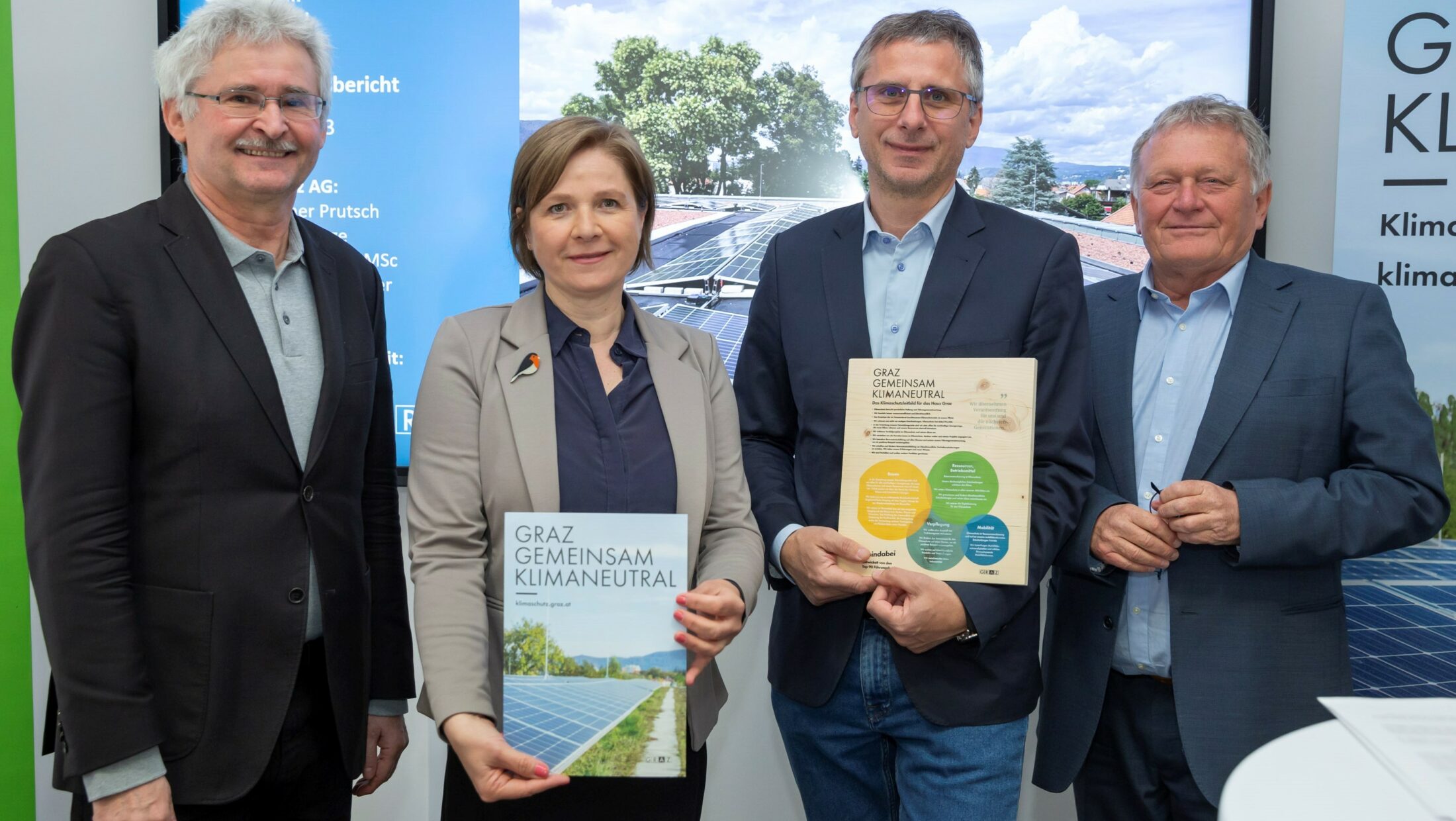The path to achieving the climate goals

Graz was the first city in Austria to draw up a detailed catalogue of measures to become climate-neutral in the House of Graz (city administration and municipal companies) by 2030.
After the unanimous decision of the municipal council on the climate protection plan in March 2022, the first progress report was prepared in intensive cooperation with many employees of the City of Graz. This includes a detailed action plan to reduce CO2 emissions in Graz and describes the path to achieving the climate goals of the City of Graz. The aim is to ensure that the city remains a liveable and humane place in the future.
Deputy Mayor Judith Schwentner explains: “The effects of climate change are becoming more and more noticeable – children and elderly people in particular suffer from tropical nights. We must now drastically reduce our CO2 emissions. As the first city in Austria, Graz has now drawn up a detailed action plan to be climate-neutral by 2030. We want to set a good example. However, in order for Graz to remain a liveable and people-friendly city in the future, we all have to take action. We can only achieve our goals together and therefore we will involve the people of Graz in the best possible way. I would like to thank all our employees for their enormous commitment, and all the people of Graz who are accompanying us on this journey.”
Action plan shows: climate goals can be achieved
Graz House has drawn up an action plan to drastically reduce its own CO2 emissions. With this pioneering achievement, the City of Graz wants to set a good example to motivate citizens, businesses and other cities to adopt climate-friendly behaviour.
The action plan includes 400 measures, which were developed by employees from all relevant areas. 70% of CO2 emissions can be reduced by 2030. 191 of these climate protection measures have the potential to save money as well as CO2. Examples of such measures are photovoltaics, building renovations or heating conversions. The action plan that has been developed makes it possible to implement climate protection measures in a sensible and efficient manner.
Magistrate Martin Haidvogl emphasises: “The report shows that the city administration and Haus Graz want to live up to their exemplary function and makes it clear that climate protection has top priority in all areas of “Haus Graz”. However, it also makes it clear that climate protection measures must be examined comprehensively in order to use the scarce resources as effectively as possible.”
Head of the Environment Office Werner Prutsch states: “Of the 400 measures developed in Haus Graz, a considerable part is also economically interesting. This is where we have to tackle and set the right priorities.”
Climate protection determines our strategies
In accordance with the climate targets set, not only should the city’s own CO2 emissions be reduced, but the entire city area should also be climate-neutral by 2040. Therefore, all urban strategies are to be aligned with the climate protection goals. Existing strategies will be evaluated and, if necessary, supplemented with measures to ensure structures for climate-friendly living.
Climate-friendly living is made possible, for example, by:
In the next step, all departments will be asked to draw up corresponding action plans.
Together for a climate-friendly, social Graz – next steps:
City of Graz and Holding Graz launch photovoltaic offensive
Through numerous larger and smaller projects, Holding Graz is making a significant contribution to reducing its greenhouse gas emissions by about 20 percent annually by 2030. Holding Graz CEO Wolfgang Malik: “Holding Graz is the number one climate protection company in the city of Graz and has already implemented numerous projects. These range from the photovoltaic panels at the Resources Park or the PV system on the municipal workshop to energy consulting measures by the Graz Energy Agency and energy-saving outdoor advertising by the announcer.”
The total electricity demand in Graz amounts to around 71 GWh per year. Based on measures of the city’s climate protection plan, a significant share of this is to be generated as renewable and local energy in the future. In addition to the significant contribution to climate protection, this will significantly increase the security of supply and price stability.
Malik: “With the project “Large-scale photovoltaic plants in the House of Graz”, PV plants with a magnitude of 30,000 MWh/a or 30 MWpeak are to be built. This would enable a total of 42% of the total electricity demand in Haus Graz of around 71,000 MWh/a to be generated as renewable local energy. With a saving of around 8,000 tonnes of CO2/year (= around 18% of the emissions from Haus Graz), the project represents the most significant single measure in the city’s climate protection plan.”
Great potential at the airport and for areas in the Graz water management area.
In addition to countless small and medium-sized areas, open spaces or larger rooftop installations are also necessary for the successful realisation of the project. In the area of the Graz waterworks in Andritz, Friesach and Feldkirchen, there are large open areas that cannot be used in any other way due to their designation as water protection areas. This means that there is considerable potential for the construction of large-scale PV systems for Graz. In order to reach the target of 30 MWp, further areas to which the City of Graz or the associated companies have access will be used for realisation. In particular, large open spaces are available at Graz Airport. Further potentials are located on roof surfaces of buildings in Haus Graz.
Photo:
Werner Prutsch, Judth Schwentner, Martin Haidvogl and Wolfgang Malik (from left).